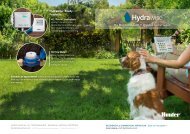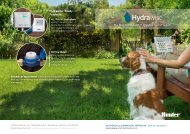Hunter Residential Sprinkler System / Irrigation system design guide - Calgary irrigation
Residential Irrigation Service and Design Guide for underground sprinklers. Learn how to design, install, service, repair and winterize your underground sprinkler system. Irrigation Calgary. Lawn irrigation. Underground sprinklers Calgary
Residential Irrigation Service and Design Guide for underground sprinklers. Learn how to design, install, service, repair and winterize your underground sprinkler system. Irrigation Calgary. Lawn irrigation. Underground sprinklers Calgary
Create successful ePaper yourself
Turn your PDF publications into a flip-book with our unique Google optimized e-Paper software.
GLOSSARY OF TERMS<br />
Arc – Circular pattern a sprinkler will rotate or spray.<br />
Backflow Preventer – A device installed between the<br />
P.O.C. and the control valves that prevents the backflow<br />
of contaminated water into the drinking water. Check<br />
with your <strong>Hunter</strong> dealer or local permitting agency for the<br />
device(s) approved for your area.<br />
Check Valve – A small device often installed in the base of a<br />
sprinkler that allows water to flow in one direction only and<br />
does not open until a pre-set pressure is reached. Is usually<br />
used to prevent low head drainage and pooling of water at<br />
the bottom of a slope or low areas.<br />
Control Valves – Automatic sprinkler control valves are<br />
valves that are activated with a low voltage output from<br />
the controller and are connected to the controller by direct<br />
burial low voltage wire. A group of control valves located<br />
together is called a manifold.<br />
Controller (Timer) – A device that uses low voltage<br />
connected via wiring to activate automatic control valves<br />
that open and allow water to flow to sprinklers for <strong>irrigation</strong>.<br />
The user sets the individual programs that consist of<br />
program start times, stations (zones or valves), run times,<br />
and watering days.<br />
Drip Control Zone Kit – A kit that includes a control valve,<br />
a filter, and a pressure regulator for drip zones.<br />
Friction Loss – Water flowing through the meter, pipe,<br />
valves, and fittings will have considerable drag or friction.<br />
When the velocity of water increases, the friction loss<br />
increases. When the diameter of the pipe increases, friction<br />
loss decreases. Friction loss reduces the available dynamic<br />
pressure.<br />
Head–to–Head – This phrase describes the correct<br />
placement of spray heads or stream rotors. One sprinkler<br />
must be placed so that it will spray another sprinkler (or<br />
50% of the adjusted diameter). This provides for complete<br />
coverage and prevents dry spots.<br />
MP Rotator – A high efficiency, low precipitation rate,<br />
rotating stream spray nozzle that can be used in place of<br />
traditional spray nozzles.<br />
P.O.C. (Point of Connection) – <strong>Sprinkler</strong> main line tie-in<br />
point. A manual shut off valve is usually installed at this<br />
point to shut off the <strong>irrigation</strong> in the event of a pipe break or<br />
to perform maintenance on the <strong>system</strong>.<br />
Poly Pipe – Polyethylene pipe is black, flexible pipe popular<br />
in areas that are susceptible to long winter freezes. Insert<br />
or compressions fittings are used to connect the pipe.<br />
Precipitation Rate – Expressed in mm/hr, precipitation rate<br />
is the rate at which water is applied. Matched precipitation<br />
means all of the sprinklers in the area are placing about the<br />
same amount of water in a given area. Different type of<br />
sprinklers should not be installed in the same zone. Large<br />
and small area sprinklers may have similar mm/hr but the<br />
area they cover is not the same and the precipitation rates<br />
would be very different.<br />
Pressure – Measured with a pressure gauge and expressed<br />
in bar or kPa. Static pressure is the pressure when no water<br />
is flowing through a closed <strong>system</strong>. Dynamic pressure is<br />
when the <strong>system</strong> is open and water is flowing though the<br />
pipes.<br />
PVC Pipe – The most common type of pipe in areas with<br />
warmer climates. Generally white in color, PVC (polyvinyl<br />
chloride) pipe is more rigid than poly pipe and uses PVC<br />
solvents to glue the pipe together.<br />
Radius – Distance that the water sprays from the sprinkler.<br />
Rotors – Gear driven sprinklers that deliver a solid stream<br />
of water and rotate slowly in a circular pattern, from 5.2 m<br />
to 23 m or more. Rotors fit into the “large area sprinklers”<br />
category.<br />
Sensor – Weather–activated shut-off device.<br />
Shut off valves – Valves used to isolate the <strong>irrigation</strong> <strong>system</strong><br />
from the water supply or to isolate sections of the <strong>irrigation</strong><br />
<strong>system</strong> for maintenance. The valve may be either a brass<br />
gate valve or a brass or plastic ball valve. Care should be<br />
used to slowly turn ball valves on or off as they only require<br />
¼ turn to open or close and could cause damage if operated<br />
rapidly.<br />
Spray Heads – <strong>Sprinkler</strong>s that emit a fan–type spay of small<br />
droplets of water. The heads have a radius of 5.2 m of less.<br />
Spray heads fit into the “small area sprinklers” category.<br />
Volume – Expressed in l/min (litres per minute). Volume is<br />
used to describe either the amount of water available or the<br />
amount of water used. The available litres per minute must<br />
be known before a sprinkler <strong>design</strong> can be completed. The<br />
total l/min of all the sprinkler heads on one zone should not<br />
exceed the available l/min.<br />
Water Hammer – The surging of pressure which occurs<br />
when a control valve is suddenly closed. In extreme<br />
conditions, this surging will cause pipes to vibrate or create<br />
a pounding noise. Water hammer is most commonly caused<br />
by fast closing valves or pipes that have been sized too<br />
small, causing high velocity water flow.<br />
Wire – In an automatic sprinkler <strong>system</strong>, low voltage direct<br />
burial wire is used to connect the automatic control valves<br />
to the controller. Colour coded, multi-strand sprinkler wire is<br />
the most common and has several coated wires together in<br />
one protective jacket.<br />
RESIDENTIAL SPRINKLER SYSTEM Design Guide<br />
29





